Of Dulcimers and Do-Re-Mi
Another art project, this one not quite finished: my friend Ron and I holed up in his shop for a few days, and made a hammered dulcimer, using padauk (or vermillion) for the soundboard, rock maple for the frame, and black walnut for the bridges.
The hammered dulcimer we made is closely related to the Azerbaijani 'santoor', which I have heard in Iranian music, and I intend to tune it appropriately, which means that the scale I encode in the strings will possibly not follow our traditional western scale. When I mentioned this to friends, they got all upset that I was violating what they saw as the 'natural' order of the traditional western scale, i.e. Do Re Mi etc.
I couldn't even make up shit like this: 'Do Re Mi' is Christian propaganda that has its roots in the medieval choral music that was used to inspire and terrify the common folk back then.
In the year 1025, in the Italian town of Arezzo, there lived a Benedictine monk known as Guido d'Arezzo. This guy taught the little choir boys to sing hymns (quite a bit different from what the Catholics are teaching choir boys nowadays), which included such hits as the following, which they sang ad nauseum to train for the real juicy songs:
This song asks the sainted John the Baptist to intercede on the behalf of said choir boys: "So that Your servants may sing at the top of one's voices the wonders of Your Acts, absolve the fault from their stained lips." Note that a lot of devotion was directed to 'Saint John', rather than to 'God'. As you might imagine, this upset the guys in the funny hats, so something would have to change.
The first syllables of the first 6 lines of this song are Ut-Re-Mi-Fa-Sol-La, which became, as the result of years of promotion by Guido d'Arezzo, the hexachordal musical notation that was all the rage throughout Christendom until the year 1625, when 'Ut' was changed to 'Do' because the song was changed (people were paying more attention to the myriad saints than they were to being fearful of hellfire, so the church modified this and many other hymns to contain more references to 'God', aka 'Dominus'), and the seventh note of our modern scale was added (also taken from the song... it started out as 'Si' for 'Sancte Iohannes', but was changed to the non-contextual 'Ti' to once again tone down the mojo of Saint John). Add the octave note 'Do' at the end, and you have our 8-note octave.
The decision to rototill the musical notes was made easier by the existence of popular medieval music that combined the Latin syllables with the notation from the Greeks, in which notes were assigned the letters A to G, a convention still used in the West. The hybrid version of these two scales ran from a low 'Gamma' ('G' in the Greek system) to a high 'Ut' (later 'Do' in the Latin, or 'C' in the Greek), so something that covered a complete scale or spectrum came to be given the name gam-ut, or gamut (as in 'run the gamut') as it has been passed down into English. See here for anecdotal confirmation of this. Bet you didn't see that coming. (The Greeks were rather practical in their naming of things: see 'alphabet', for instance).
The treble clef, that squiggly sign that they put on the left edge of the musical staff, is actually a fancy letter 'g', since the higher musical register was referenced from its 'highest' note ('G' sits right on top of the top line of the treble clef). Similarly the bass clef, that thing that looks like a backwards 'c' with two dots near it, is actually a fanciful monkified 'F'.
I was taught in school as a child (Do, a deer, a female deer, Re, a drop of golden sun...) that there was something Right and Proper about our Western musical scale, at least in a mathematical sense if not actually Written by the Moving Finger of God. This is pretty clearly a cultural bias, something I know from personal experience: when I was in India studying the sitar, I was taught that it was Natural and Proper and God-given for there to be 22 notes known as 'shrutis' in a scale. 12 of these match up with the 12 notes of our sharped/flatted DoReMiEtc scale, and therefore 8 of those match up directly with the 'natural' notes of our scale, which are not known as Do-Re-Mi-Etc since in Sanskrit the DoReMi notes are as follows:
When learning sitar, or any other Indian musical instrument, you learn little songs made up of these syllables, or others like them; this is the oral tradition through which this music was passed down for centuries. There is a tune I can play on the tabla, for instance, called 'teen tal', which goes like so:
The singing of this musical notation has become an art form in and of itself, which has in recent years broken into the American musical horizon mostly by the tireless pursuits of aging musical hipsters like Sting, U2, and Peter Gabriel, who seek out guest talent such as the late Nusrat Fateh Ali Khan, whose Pakistani qawwali music is based in this tradition (though the term qawwali itself translates as "utterance" in Urdu, and stems from the Arabic qua'ol, meaning an expression recited to purify mind and action, the musical term has since come to mean the 'utterance' of the aforementioned musical notation).
The 22 shrutis in Indian music are something of a superset of our DoReMi, so I looked further to find out whether other musical traditions are completely different. It turns out that there are literally hundreds of scales, with varying numbers of notes (26 in Arabic maqams, 31 in Hemiolic Chromatic Hypophrygian, 53 in Persian and Turkish makams), yet they all have notes that coincide with 'western' notes. They also have many other notes that we are not encultured to hear as 'musical'.
What does all this have to do with dulcimers? Though I based my design on the santoor, the main reason I built a 'hammered dulcimer' instead of for instance a 'boat' is that I saw a video of a band called Dead Can Dance in which there was a woman playing what I thought was a hammered dulcimer. As I try to tune my santoorish dulcimer to be able to play similar music to what she played, I find that some of the strings need to be tuned to slightly different notes from what I expected... in fact, octave notes (g to G for instance) are not 8 or even 12 strings apart, but something more like 15 or 17 strings apart (I still haven't got it all worked out). When tuned to these non-standard notes, the device lends itself quite nicely to the type of music I wish to create. Of course, it is possible (even probable based on my recent experience trying to tune this thing) that some of her strings were simply slightly out of tune; there are a hell of a lot of strings on the damn thing, and keeping them all dialed in is quite a chore. A nice pentatonic scale, with grace notes provided by the strings that are slightly out of tune, sounds great, floating ethereal dream music.
A little research showed that the instrument played in the Dead Can Dance video was not a dulcimer per se, or even a santoor, but a Chinese instrument known as a "yang ch'in" or possibly "yangqin". Very similar in design, but tuned and played in a slightly different manner.
Anyway, to tie this all up: though I had originally intended to tune the dulcimer to a non-standard tuning to pay appropriate homage to the influences that... ummm... influenced me, I now intend to tune the 'dulcimer' to a non-standard tuning to further reinforce my rebellion against the fucking Christians. It doesn't really change anything, but it makes me feel better. So, here it is, the Amazing Incredible Flying Hammered Dulcimer of Doom.
You can click on the pictures to get a larger view.
After looking at many hardwoods, I chose the padauk for its beauty and its tone. Bill at Scotty's Hardwoods in Springfield split the wood into thin planks and thickness sanded them for me.
Measure like twenty times, cut once. *whew*
We clamped the soundboards together. I found out later that there are oils in padauk that need to be cleaned off with alcohol before gluing... and a glue line split. Live and learn.
Next we got started on the frame, which mostly due to my inexperience making anything remotely like this, turned out to be quite formidable... I didn't feel comfortable with a light and airy instrument, when the total string tension is over a ton.
After coming up with some ingenious and over-engineered joints, we had a completed frame.
We then glued up the back and frame and clamped the hell out of them.
One of the back joints split, so after a quick repair (unnoticeable from the outside of the instrument) we added bracers under the bridge locations.
We then clamped the front soundboard on.
After a little cleaning, it was starting to look like a dulcimer.
I laid out templates for the locations of the tuning pins and end pegs, and marked the wood with a center punch.
Using a guide to make sure the tuning pegs would be perpendicular, I drilled a rather large number of holes.
The dulcimer is ready for tuning pins.
Artistically I am very pleased with the results; now it is a matter of getting music out of the thing. Another post, another time...
The hammered dulcimer we made is closely related to the Azerbaijani 'santoor', which I have heard in Iranian music, and I intend to tune it appropriately, which means that the scale I encode in the strings will possibly not follow our traditional western scale. When I mentioned this to friends, they got all upset that I was violating what they saw as the 'natural' order of the traditional western scale, i.e. Do Re Mi etc.
I couldn't even make up shit like this: 'Do Re Mi' is Christian propaganda that has its roots in the medieval choral music that was used to inspire and terrify the common folk back then.
In the year 1025, in the Italian town of Arezzo, there lived a Benedictine monk known as Guido d'Arezzo. This guy taught the little choir boys to sing hymns (quite a bit different from what the Catholics are teaching choir boys nowadays), which included such hits as the following, which they sang ad nauseum to train for the real juicy songs:
Ut queant laxis
resonare fibris
mira gestorum
famuli tuorum,
solve polluti
labii reatum,
Sancte Iohannes.
This song asks the sainted John the Baptist to intercede on the behalf of said choir boys: "So that Your servants may sing at the top of one's voices the wonders of Your Acts, absolve the fault from their stained lips." Note that a lot of devotion was directed to 'Saint John', rather than to 'God'. As you might imagine, this upset the guys in the funny hats, so something would have to change.
The first syllables of the first 6 lines of this song are Ut-Re-Mi-Fa-Sol-La, which became, as the result of years of promotion by Guido d'Arezzo, the hexachordal musical notation that was all the rage throughout Christendom until the year 1625, when 'Ut' was changed to 'Do' because the song was changed (people were paying more attention to the myriad saints than they were to being fearful of hellfire, so the church modified this and many other hymns to contain more references to 'God', aka 'Dominus'), and the seventh note of our modern scale was added (also taken from the song... it started out as 'Si' for 'Sancte Iohannes', but was changed to the non-contextual 'Ti' to once again tone down the mojo of Saint John). Add the octave note 'Do' at the end, and you have our 8-note octave.
The decision to rototill the musical notes was made easier by the existence of popular medieval music that combined the Latin syllables with the notation from the Greeks, in which notes were assigned the letters A to G, a convention still used in the West. The hybrid version of these two scales ran from a low 'Gamma' ('G' in the Greek system) to a high 'Ut' (later 'Do' in the Latin, or 'C' in the Greek), so something that covered a complete scale or spectrum came to be given the name gam-ut, or gamut (as in 'run the gamut') as it has been passed down into English. See here for anecdotal confirmation of this. Bet you didn't see that coming. (The Greeks were rather practical in their naming of things: see 'alphabet', for instance).
The treble clef, that squiggly sign that they put on the left edge of the musical staff, is actually a fancy letter 'g', since the higher musical register was referenced from its 'highest' note ('G' sits right on top of the top line of the treble clef). Similarly the bass clef, that thing that looks like a backwards 'c' with two dots near it, is actually a fanciful monkified 'F'.
I was taught in school as a child (Do, a deer, a female deer, Re, a drop of golden sun...) that there was something Right and Proper about our Western musical scale, at least in a mathematical sense if not actually Written by the Moving Finger of God. This is pretty clearly a cultural bias, something I know from personal experience: when I was in India studying the sitar, I was taught that it was Natural and Proper and God-given for there to be 22 notes known as 'shrutis' in a scale. 12 of these match up with the 12 notes of our sharped/flatted DoReMiEtc scale, and therefore 8 of those match up directly with the 'natural' notes of our scale, which are not known as Do-Re-Mi-Etc since in Sanskrit the DoReMi notes are as follows:
Sa-Re-Ga-Ma-Pa-Da-Ni-Sa
When learning sitar, or any other Indian musical instrument, you learn little songs made up of these syllables, or others like them; this is the oral tradition through which this music was passed down for centuries. There is a tune I can play on the tabla, for instance, called 'teen tal', which goes like so:
dha ti-re ki ta taka
dha ti-re ki ta taka
dha ti-re ki ta taka
dhu na ki ta taka
The singing of this musical notation has become an art form in and of itself, which has in recent years broken into the American musical horizon mostly by the tireless pursuits of aging musical hipsters like Sting, U2, and Peter Gabriel, who seek out guest talent such as the late Nusrat Fateh Ali Khan, whose Pakistani qawwali music is based in this tradition (though the term qawwali itself translates as "utterance" in Urdu, and stems from the Arabic qua'ol, meaning an expression recited to purify mind and action, the musical term has since come to mean the 'utterance' of the aforementioned musical notation).
The 22 shrutis in Indian music are something of a superset of our DoReMi, so I looked further to find out whether other musical traditions are completely different. It turns out that there are literally hundreds of scales, with varying numbers of notes (26 in Arabic maqams, 31 in Hemiolic Chromatic Hypophrygian, 53 in Persian and Turkish makams), yet they all have notes that coincide with 'western' notes. They also have many other notes that we are not encultured to hear as 'musical'.
What does all this have to do with dulcimers? Though I based my design on the santoor, the main reason I built a 'hammered dulcimer' instead of for instance a 'boat' is that I saw a video of a band called Dead Can Dance in which there was a woman playing what I thought was a hammered dulcimer. As I try to tune my santoorish dulcimer to be able to play similar music to what she played, I find that some of the strings need to be tuned to slightly different notes from what I expected... in fact, octave notes (g to G for instance) are not 8 or even 12 strings apart, but something more like 15 or 17 strings apart (I still haven't got it all worked out). When tuned to these non-standard notes, the device lends itself quite nicely to the type of music I wish to create. Of course, it is possible (even probable based on my recent experience trying to tune this thing) that some of her strings were simply slightly out of tune; there are a hell of a lot of strings on the damn thing, and keeping them all dialed in is quite a chore. A nice pentatonic scale, with grace notes provided by the strings that are slightly out of tune, sounds great, floating ethereal dream music.
A little research showed that the instrument played in the Dead Can Dance video was not a dulcimer per se, or even a santoor, but a Chinese instrument known as a "yang ch'in" or possibly "yangqin". Very similar in design, but tuned and played in a slightly different manner.
Anyway, to tie this all up: though I had originally intended to tune the dulcimer to a non-standard tuning to pay appropriate homage to the influences that... ummm... influenced me, I now intend to tune the 'dulcimer' to a non-standard tuning to further reinforce my rebellion against the fucking Christians. It doesn't really change anything, but it makes me feel better. So, here it is, the Amazing Incredible Flying Hammered Dulcimer of Doom.
You can click on the pictures to get a larger view.
After looking at many hardwoods, I chose the padauk for its beauty and its tone. Bill at Scotty's Hardwoods in Springfield split the wood into thin planks and thickness sanded them for me.
Measure like twenty times, cut once. *whew*
We clamped the soundboards together. I found out later that there are oils in padauk that need to be cleaned off with alcohol before gluing... and a glue line split. Live and learn.
Next we got started on the frame, which mostly due to my inexperience making anything remotely like this, turned out to be quite formidable... I didn't feel comfortable with a light and airy instrument, when the total string tension is over a ton.
After coming up with some ingenious and over-engineered joints, we had a completed frame.
We then glued up the back and frame and clamped the hell out of them.
One of the back joints split, so after a quick repair (unnoticeable from the outside of the instrument) we added bracers under the bridge locations.
We then clamped the front soundboard on.
After a little cleaning, it was starting to look like a dulcimer.
I laid out templates for the locations of the tuning pins and end pegs, and marked the wood with a center punch.
Using a guide to make sure the tuning pegs would be perpendicular, I drilled a rather large number of holes.
The dulcimer is ready for tuning pins.
Artistically I am very pleased with the results; now it is a matter of getting music out of the thing. Another post, another time...
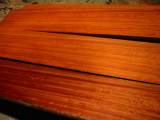
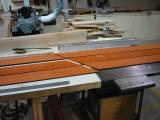
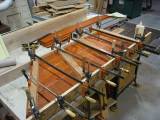
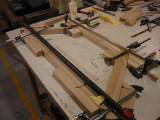
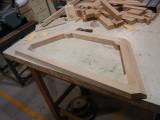
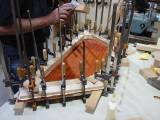
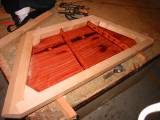
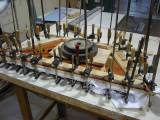
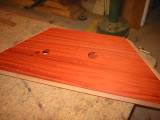
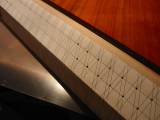

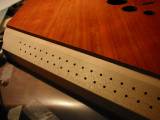
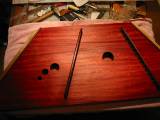

return to front page